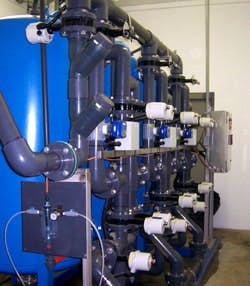In 2005, the Michigan Department of Environmental Quality (MDEQ) reported more than 200 public water systems that at one time exceeded the new arsenic treatment standard of 10 parts per billion (ppb). Many sites have taken measures to mitigate this situation by drilling new wells, connecting to other available public water sources or installing new treatments.
The Lakeview Estates Mobile Park in Durand, Mich., was one of those sites. The system, with 239 connections, is served by 14 low-producing wells that together deliver up to 200-gal-per-minute (gpm) design flow to the mobile home park. The raw water has arsenic at 20 ppb, iron at 0.5 parts per million (ppm) and manganese at 0.1 ppm, all of which exceed primary and secondary drinking water standards.
In August, 2007, the site’s engineers chose AdEdge Technologies, Inc. , to supply a packaged arsenic, iron and manganese treatment system for the mobile home park. The park only had chlorination and sequestration using polyphosphates in place before adding the arsenic treatment system.
Several options, including adsorption, were considered for the site. Conventional adsorption was eliminated from consideration based on the high iron and manganese levels in the raw water that could potentially foul or interfere with the technology. Instead, an AdEdge AD26 oxidation/filtration system , which uses an NSF Standard 61-certified manganese dioxide media, was selected to remove the iron, manganese and arsenic based on its overall cost, small footprint and simplicity.
The site’s engineer, VEC Engineering, and Tri-County Drilling, which took part in constructing a new block-building expansion to house the equipment, were granted an MDEQ permit in November 2007.
The arsenic treatment train consists of a completely integrated packaged treatment system with three vessels in parallel to treat up to 200 gpm. The 36-in.-diameter treatment vessels are made of epoxy-lined carbon steel with an automated valve harness and piping. Only prechlorination using liquid sodium hypochlorite is necessary for contaminant removal and disinfection. About 15 to 30 seconds of contact time for the chlorine is needed for the process, which is considerably less than other approaches that require 10 to 30 minutes and a separate contact tank. The media is backwashed 2 times per week, so it can be used multiple times.
Installation at the mobile home park was completed late in 2007. Since operations began in January 2008, the system has consistently met all the U.S. Environmental Protection Agency MCLs for arsenic, iron and manganese. Arsenic in the treated water has been recorded consistently below detection (less than 2 ppb). Monitoring the system and replenishing chlorine require less than one hour of operating time per week.
In addition to arsenic removal, residents of the mobile home park saw aesthetic improvements in the water since the iron and manganese are no longer present. Also, the polyphosphate addition iron sequestration was eliminated for additional cost savings. The expected operating cost for the system, including prorated media replacement after 10 years, chemicals and utilities, was less than $0.15 per 1,000 gal, or less than $1.25 per connection.
